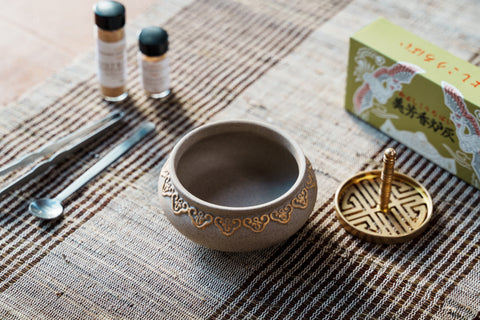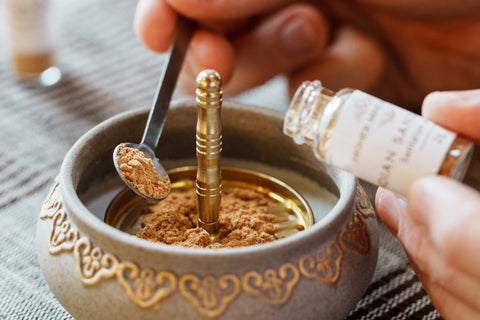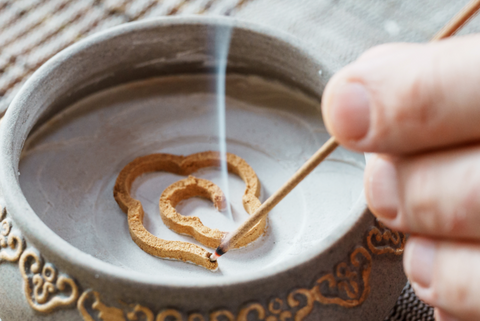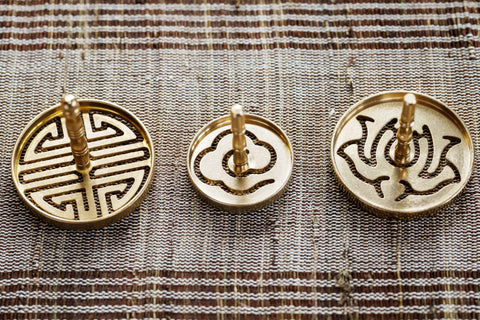The Story of Ancient Incense Clocks

How would you tell time without your iPhone, watch, or digital clock? Before the invention of electricity and modern technology, ancient peoples would often use the elements of the natural world to help with understanding and communicating time. Anything that moves with consistency can be a timepiece. Throughout history, humans have determined the time using the sun, water, and sand – and even fire and smoke, through the burning of incense.
You are probably familiar with the sundial – known as the earliest form of timekeeping device – which indicates the time of day by the position of the shadow from the sun. There were also water clocks, which told time by the measured flow of water into or out of a vessel; and sand timers, or hourglasses.
Another fascinating ancient way of keeping time is through burning incense. Utilizing the power of fire, the incense clock intricately forms a maze of incense ash, employing both its aroma and the ash itself as components for timekeeping. Incense clocks, or incense trails or stencils, were a major part of ancient Chinese culture, and have also been found throughout ancient Japanese, Indian, Tibetan, and other cultures.
In this article, we’ll reveal the captivating history and beautiful tradition of ancient incense clocks and their role in ancient society. You’ll also learn about the types of aromatic plants commonly used in incense clocks and how these classic time-telling pieces can bring simple beauty, enjoyment, and fun into your life.
Ancient Incense Clock History
To describe the passing of time or estimate how long certain things might take, ancient peoples would use expressions of common experiences, like the time required to drink a cup of tea, eat a bowl of rice, travel a certain distance, or burn a stick of incense. An expression frequently seen in ancient Chinese writings is “i chu hsiang ti shih hou,” which translates to “the time of burning an incense stick,” a common phrase used in China to indicate a lapse of time [1].
Incense has played an important role in many aspects of daily life in East Asian countries, from religious, ceremonial, and spiritual use, to practical and medicinal purposes. Because of its widespread use and popularity in ancient Chinese culture, burning incense unsurprisingly evolved into a frequently used standard of measurement. It was for this reason that incense clocks were created.
According to Silvio Bedini, a historian who studied incense clocks in-depth, “the use of fire and incense for time measurement has an extensive history, examples having been noted as early as the sixth century AD” [2]. Bedini says that incense clocks were used just as frequently and extensively as sundials.
Tradition & Use of Ancient Incense Clocks & Stencils
Incense clocks tell time by the gradual burning of specific types of powdered incense that were calibrated to burn at a consistent rate. These clocks were equipped with different compartments or markings that indicated the passage of time as the incense burned. Each type of incense clock varied in design and mechanism, but the basic blueprint involved several trays, a few intricate labyrinth-designed stencils, a spatula or leveler tool, and a latticework lid to help keep the incense lit.
First, the user would set up the incense clock by creating a pre-measured powdered incense trail using an exquisite stencil, with each stencil representing a different amount of time. Bedini suggests that the different stencils represented different seasons: the longer ones were meant for bottomless, dark winter nights, while the shorter ones were best suited for summer [2]. They would then use the leveler tool to flatten the incense and make it uniform, then light the incense to start the timekeeper.

Sometimes people would insert a different aromatic plant along the trail as a time marker, or add a single wood chip of a different plant along the powdered incense path so that they could tell the changing of time by the shift in scent as it burned. While most ancient timekeeping methods depended solely on vision, incense clocks could uniquely integrate both the sense of smell and sight to measure time.
Incense clocks were traditionally used for a wide variety of purposes, including religious rituals, and in temples for religious rites, where precise timing was crucial for ceremonies and offerings. They were also helpful in providing a gentle timer during meditation sessions–which can be one of many great ways to put incense stencils to use in modern times.
Incense clocks also served as timekeepers in daily life and or as a timer for specific activities. They were used in agriculture for measuring water for irrigation, in palaces and government offices, and during the studies of scholars [1]. Some incense clocks were ornately designed, reflecting cultural aesthetics and beliefs, and they held cultural significance beyond their timekeeping function.

Common Aromatic Plants for Incense Clocks
Different cultures utilized a range of fragrant plants in their incense clocks, with the two most predominant botanicals being Sandalwood and Agarwood (also known as Aloeswood or Oud), primarily in the form of fine powders.
Highly prized for its rich and complex scent, Aloeswood is a luxurious ingredient used in premium incense and high-end natural perfumes due to its rarity and captivating aroma.
Sandalwood is another intoxicating aromatic hardwood commonly used in meditation, thanks to its ability to calm the mind and soothe stress and anxiety. Sandalwood’s aroma is incredibly light, sweet, and slightly floral, and is often described as simply heavenly.
It is important to mention that Indian Sandalwood is currently considered a vulnerable species due to high global demand, illegal trade, and over-harvesting. You can find sustainably and ethically sourced Indian Sandalwood on our online store here. Our Indian Sandalwood powder is fair-trade and plantation-grown on an Australian tree farm, and its sale promotes the future growth of the species.

Incense Stencils Today
Although incense clocks are no longer commonly used for timekeeping purposes today, they remain an intriguing part of ancient timekeeping history and cultural heritage, and incense stencils can make a fun and fulfilling addition to your incense-burning practice.
The slow, calming burn of incense in these stencils serves as a mesmerizing timer for meditation or relaxation exercises, providing a more traditional and sensory experience. You may also want to use an incense stencil to simply enjoy as an aromatic medicine or incense connoisseur treasure and to hold a piece of aromatic history. Whatever the reason, incense stencils make a beautiful and unique addition to any aromatic medicine practice.
References
- Bedini, S. A. (1994). The Trail of Time: Time Measurement with Incense in East Asia. Cambridge University Press.
- Bedini, S. A. (1963). The Scent of Time. A Study of the Use of Fire and Incense for Time Measurement in Oriental Countries. Transactions of the American Philosophical Society, 53(5), 1–51. https://doi.org/10.2307/1005923
© 2024 The Northwest School of Aromatic Medicine. All rights reserved.
*The statements above have not been evaluated by the FDA, and are for educational purposes only. This article is not intended to diagnose, treat, cure, or prevent any disease. This article should not be taken as medical advice. Please consult your physician before you use this information for health purposes.








